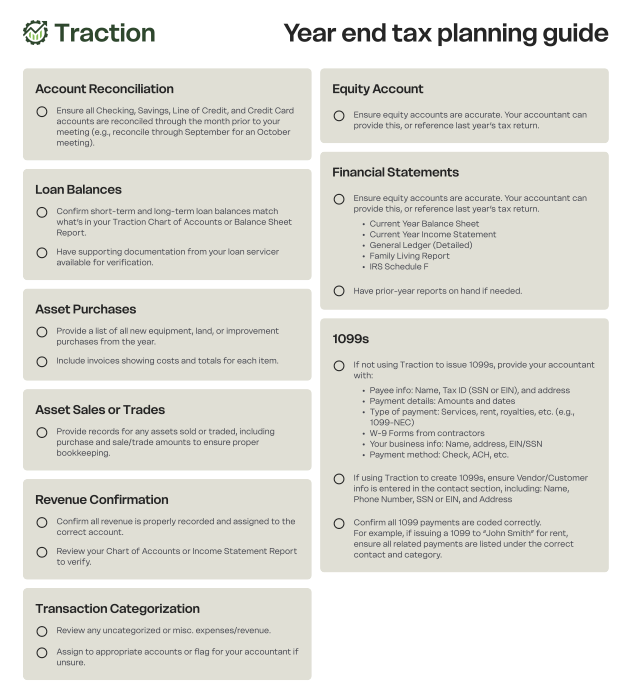Stay On Top Of Year End Farm Tax Planning With A Printable Checklist
Farming income is often unpredictable and can fluctuate significantly from year to year due to factors like market prices, weather, and yield variations. Tax planning helps smooth out this variability. As year-end approaches, it’s time for us to turn our attention to accounting and tax planning—essential steps that can significantly influence the financial health of your operation. Whether you’re working with a calendar year-end or a fiscal year-end, these meetings are crucial for maximizing your tax benefits and preparing for the upcoming season.
Proper tax planning allows you to better manage cash flow, which is especially important in farming where expenses can be seasonal and substantial. By planning ahead, you can avoid surprises and prepare for tax payments, ensuring you have enough cash on hand when tax liabilities come due. Tax planning also helps you decide whether it makes sense to accelerate or defer income and expenses, depending on your financial needs and tax position.
This checklist will guide you through key topics to consider as you prepare for your accounting meetings. Well-maintained financial records allow you or your accountant to quickly organize and report income, expenses, and deductions. Plus, having a detailed record of expenses ensures that you claim all the deductions you’re entitled to, which can significantly reduce your tax burden.
Download this printable year end tax planning checklist to ensure you’re well prepared for your tax accountant meetings!

Year-end tax planning checklist
Ensure you've covered all your bases before the end of the year with this comprehensive checklist. Simply check off each item as you complete it to stay organized and prepared.
1. Account reconciliation
Ensure monthly reconciliations are completed for all Checking, Savings, Line of Credit, and Credit Card accounts up to the month prior to the meeting. For example, for an October tax planning meeting, accounts should be reconciled through September.
2. Loan balances
Verify that short-term and long-term loans match the actual balances due to loans. Balances of loans can be seen in your Traction Chart of Accounts or by running a Balance Sheet Report.
Ensure supporting documentation from loan servicer is available to confirm the loan balances for your accountant.
3. Asset purchases
Provide a detailed list of any new equipment, land purchases, or land improvements made throughout the year.
Include invoices with costs and totals for all newly purchased assets.
4. Asset sales or trades
*Provide documentation for any assets sold or traded. Documentation should include all purchase and trade-in totals to confirm they are properly recorded on books.
5. Revenue confirmation
Confirm that all revenue has been properly recorded and assigned to a revenue account. If reviewing in your Traction account, this can be found by looking at your Traction Chart of Accounts or viewing the Income Statement Report.
6. Transaction categorization
Review any transactions in uncategorized or miscellaneous expense and revenue accounts. If possible, assign the transactions in these accounts to the appropriate account, or prepare questions for your accountant regarding what accounts they should be assigned to.
7. Equity account
Ensure that all equity accounts are accurate. Your accountant can provide you with the equity balances, or they may be available on your prior year’s tax return.
8. Financial statements
Bring copies of the following reports from Traction for all entities for your accountant:
- Current Year Balance Sheet
- Current Year Income Statement Report
- Current Year General Ledger Detailed Report
- Current Year Family Living Report
- IRS Schedule F
* Prior year reports may also be requested, so have them available if needed.
9. 1099s
If you are not using Traction to create your 1099s, your accountant may request the following information in order to create 1099s for your recipients:
- Payee Information: Name, Tax ID (SSN or EIN), and address
- Payment Details: Total paid and date of payments
- Type of Payments: Services, rent, royalties, or other income types (e.g., 1099-NEC for non-employee compensation)
- W-9 Forms: Contractor-provided tax information
- Your Business Info: Name, address, and EIN/SSN
- Payment Methods: How payments were made (e.g., check, ACH)
If you use Traction to create your 1099s, confirm that you have the Vendor/Customer information entered into the contact section of Traction, including Name/Business Name, Phone Number, Social Security Number or Tax Identification number, and Address.
Confirm all payments made to the recipient who will be receiving a 1099 from you are coded to the correct account. For example, if you are issuing a 1099 to John Smith for land rented, confirm that all rent payments have “John Smith” in the contact section and that all payments are posted in the same expense account.
10. Attend Traction webinars
Register and attend Traction webinars to stay updated on the latest features and best practices.
Farm accounting that just works.
Tired of hacking workarounds in software that wasn’t built for farms? We made Traction Ag just for you.

Agape Farms in Ohio



